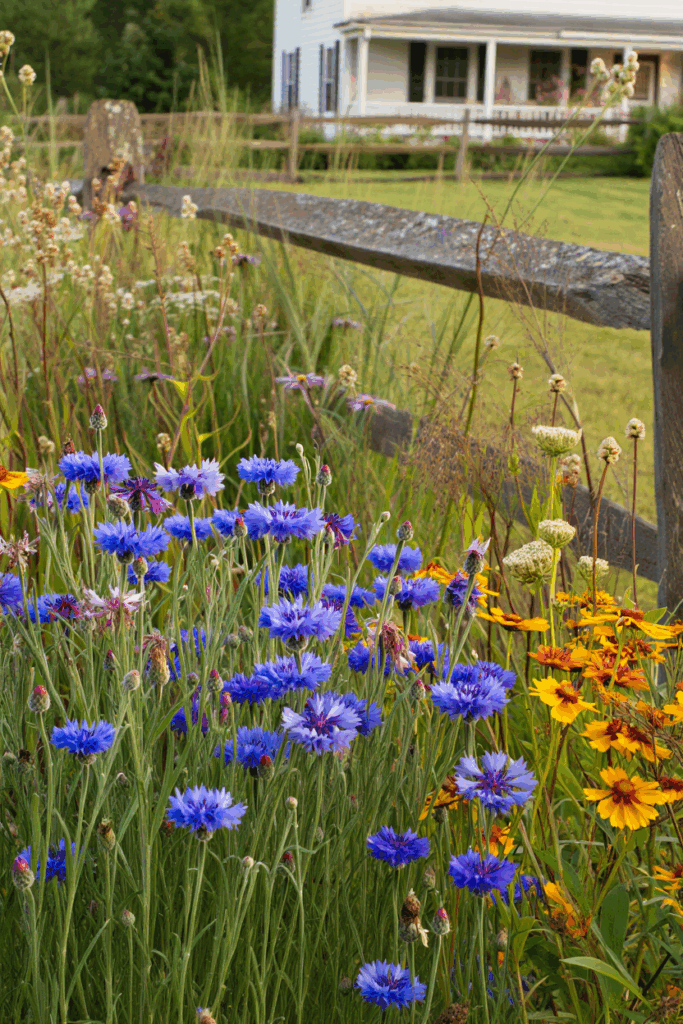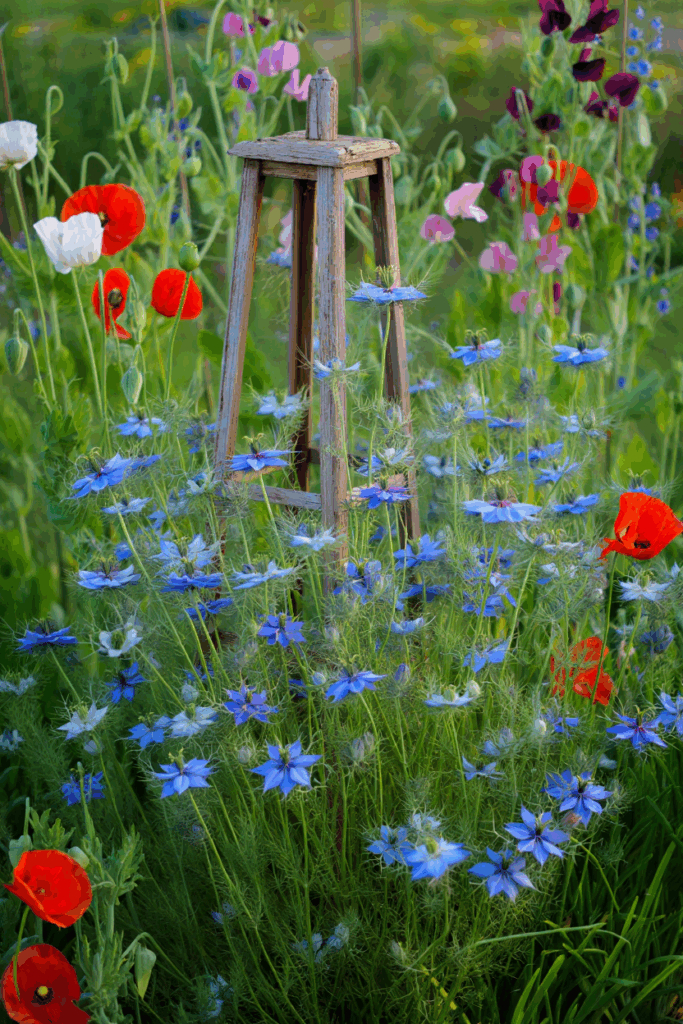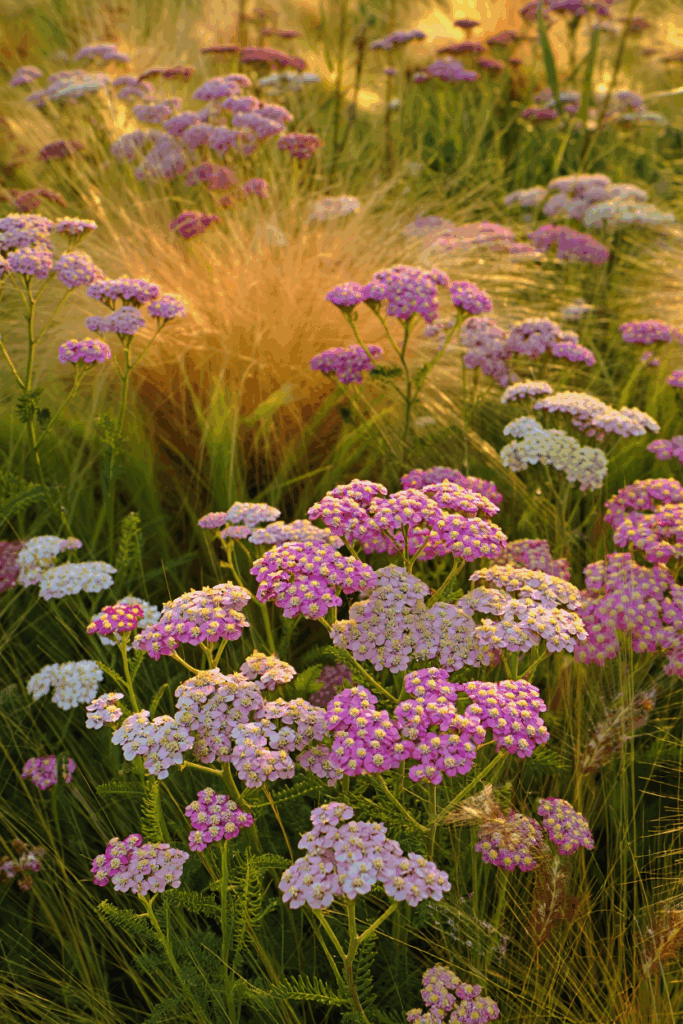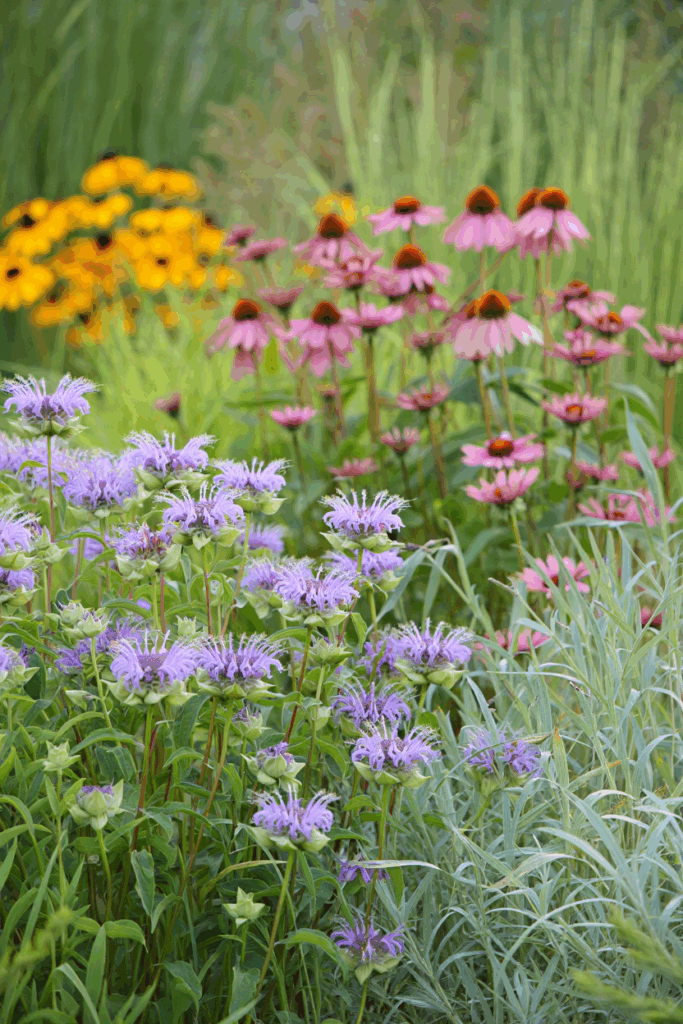
Both the garden and I seem to get a second wind in September. After the long, mellow stretch of summer, I feel ready to turn back toward the soil with renewed purpose. Fall is a season of gathering and gratitude, but it’s also a time for planting—quiet beginnings that prepare the way for next year’s garden.
Scattering wildflower seed in autumn is one of the simplest, most rewarding tasks. Many wildflowers need winter’s chill to break dormancy, and sowing now mimics nature’s own cycle. By spring, those seeds will be ready to sprout without any extra work from you. It’s a small investment of effort at just the right time, and the reward is a garden that feels effortlessly naturalized—alive with color, buzzing with pollinators, and stitched into the rhythm of the seasons.
If you’ve been looking for an easy way to add charm and diversity to your beds, borders, or meadows, here are 13 wildflowers to scatter this fall for a spring garden that feels both wild and wonderfully alive.
Why Autumn is the Best Time to Direct Sow Wildflower Seeds
Most gardeners think of spring as planting season—but I’ve learned that fall is the secret window for wildflowers. When the days cool and the light turns golden, I don’t just tidy beds and put tools away—I scatter seed. It feels like such a small act, but it’s one that pays off beautifully when spring arrives. Here’s why I save my wildflower sowing for autumn:

1. Following Nature’s Lead: Out in the meadow, wildflowers drop their seeds in autumn. They lie dormant under leaves and soil all winter, then wake up at the perfect time in spring. By sowing now, I’m simply mimicking that cycle—and my germination rates are always better for it.
2. Less Competition in Spring: By September, weeds are winding down. Annuals are finishing their life cycle, and perennials are going dormant. That means my wildflower seedlings don’t have to fight so hard for space, water, and light when they start growing in spring.
3. Weather That Helps, Not Hurts: Autumn’s cooler days, longer nights, and steady rains help seeds settle into the soil. They don’t dry out as quickly, and I don’t have to hover with a watering can. It’s an easier, gentler start.
4. Stronger Plants by Summer: Even when I don’t see much happening above ground, the seeds are busy putting down roots all winter. By the time hot, dry weather arrives, those plants are already tougher and more resilient than anything I’ve sown in April.
5. Cold Stratification the Easy Way: Some seeds—like coneflowers, lupines, and milkweed—need a stretch of cold to crack open their shells. If I plant them in spring, I either have to simulate that in the fridge or wait another year. By sowing in fall, winter takes care of it for me.
16 Easy Wildflowers You Can Direct Sow Outside in Fall
Here are 16 wildflowers you can direct sow outside in fall (a.k.a., sprinkle and strut away like the plant boss you are):
1. Cornflowers (Centaurea cyanus)
If ever a flower deserved the title of “painter’s muse,” it would be the cornflower. That vivid, electric blue seems almost unreal, like a brushstroke pulled straight from a countryside canvas. Once common in European wheat fields, it has since become a beloved garden annual, especially for those of us who crave a splash of wild, untamed color.

What I love most about cornflowers is how little they ask of us. They don’t want rich compost or coddling; they thrive in poor, sandy soil and full sun, the very conditions that frustrate more delicate plants. Sown in fall in Zones 3 through 7, the seeds rest under winter’s cover, then spring to life as soon as the soil warms. In warmer Zones 8 and above, wait until late fall or early winter to scatter them, so they don’t sprout too soon during mild autumn weather. Gardeners in the coldest regions can start them indoors late in winter and transplant them once the ground is workable.
By late spring, they’ll be swaying on wiry stems, buzzing with bees and butterflies who can’t resist that striking color. If you leave a few seed heads standing, goldfinches will stop by to feast on them too. Indoors, they’re surprisingly long-lasting cut flowers, holding their blue brilliance in a vase as if determined not to fade. Plant them once, and you’ll likely find them popping up on their own for years to come, weaving themselves into the rhythm of your garden.
2. Poppies (Papaver rhoeas)
Few flowers capture the heart like poppies. Their petals are so thin they seem spun from silk, fluttering in the lightest breeze, glowing like lanterns in shades of scarlet, pink, or pure white. A single bloom is striking, but a drift of them across a border or meadow is unforgettable—romance made real in the garden.

Poppies are easygoing once you understand their rhythm. They dislike being transplanted, so the best way is always to direct sow. In Zones 3 through 7, scatter seed in fall, letting winter’s chill stratify them.
In warmer Zones 8 and above, wait until late fall or early winter, so seedlings don’t emerge too soon. Seeds are tiny—just press them into the soil surface without burying them too deeply, since they need light to germinate.
By late spring, you’ll have fields of papery blooms, followed by charming seedpods that can be left for reseeding or snipped for dried arrangements. Plant them once and, with a little luck, poppies will come back year after year, weaving themselves into your garden’s story.
3. Nigella (Love-in-a-Mist)
Nigella is the kind of flower that makes you pause and look closer. Its blossoms—soft blue, purple, or white—are delicate enough on their own, but it’s the fine, lacy foliage that frames each bloom in a feathery halo, earning it the name Love-in-a-Mist.

Even after the flowers fade, the swollen, balloon-like seedpods add whimsy and structure, perfect for drying in autumn arrangements.
This is a plant best sown directly where you want it to grow, since it dislikes being moved. In Zones 3 through 7, sow in fall so the seed can settle through winter, while in Zones 8 and warmer, wait until late fall or even early winter for best results. Nigella thrives in full sun and average, well-drained soil, reseeding generously if you allow some pods to shatter in place. By late spring, its airy, fairy-tale quality brings softness to borders and cutting gardens alike, proving that charm doesn’t have to come with fuss.
4. Prairie Coneflower (Ratibida columnifera)

Prairie coneflower, sometimes called Mexican hat, is a native prairie classic with a playful shape—drooping petals in shades of yellow or red surround a tall, dark central cone, giving it the look of a tiny dancer’s skirt. It’s tough, drought-tolerant, and long-blooming, thriving in open meadows and sunny borders where it brings both whimsy and resilience.
In Zones 3 through 8, sow seeds in fall so they can experience the cold stratification they need. In warmer Zones 9 and above, wait until late fall or early winter to sow, choosing a sunny, well-drained site. Once established, prairie coneflower blooms from early summer well into fall, providing nectar for pollinators and seeds for finches and sparrows. With its unique form and ability to handle dry soils, it’s a wildflower that adds both beauty and character to naturalized plantings.
5. Black-eyed Susan (Rudbeckia hirta)
If there’s one native wildflower that feels like pure sunshine in plant form, it’s the Black-eyed Susan. With their golden-yellow petals and dark, chocolate-brown centers, they light up meadows and borders from midsummer through fall, often blooming when other flowers are fading. Their cheerful faces are more than ornamental—they’re a vital nectar source for bees and butterflies, while the seed heads provide food for finches and other birds later in the season.

Black-eyed Susans are incredibly adaptable. In Zones 3 through 7, sowing in fall gives the seeds the cold stratification they need, ensuring strong germination in spring. In warmer Zones 8 and above, sow later in fall or even early winter, so seedlings don’t sprout too early. Once established, they’re drought-tolerant and perfectly at home in poor or average soils, thriving best in full sun. As a short-lived perennial or biennial, they reseed generously, slowly weaving themselves into a naturalized tapestry that returns year after year.
Planting Black-eyed Susans is like inviting the spirit of the prairie into your garden. Hardy, bright, and beloved by pollinators, they bring both beauty and ecological value, proving that native wildflowers can hold their own alongside any cultivated bloom.
6. Purple Coneflowers (Echinacea purpurea)
Coneflowers are the backbone of many native meadows, and for good reason. Their bold, daisy-like blooms—usually in shades of purple-pink with a spiky, orange-brown cone—stand tall and proud through the heat of summer. Few plants attract such a wide crowd: bees and butterflies visit daily, while goldfinches eagerly pick over the seed heads once the petals fade.

Direct sowing in fall works beautifully in Zones 3 through 7, since the cold months naturally break the seeds’ dormancy. In warmer Zones 8 and above, seeds benefit from an artificial chill—either refrigerate them before sowing in late winter, or scatter them outdoors in December or January when the soil is cool. Coneflowers thrive in full sun and tolerate a wide range of soils, even dry, sandy spots where fussier flowers fail.
Though technically perennial, they take their time to establish, often flowering in their second year. But once they settle in, they’re incredibly reliable, returning each summer with stronger clumps and bigger blooms. Let some seed heads stand, and you’ll find them naturalizing quietly, spreading through the garden as if they’ve always belonged there. Hardy, beautiful, and resilient, coneflowers are one of the best gifts North America has given to gardeners.
7. Coreopsis (Coreopsis tinctoria)
Coreopsis, often called tickseed, is one of those wildflowers that makes a garden feel instantly cheerful. Its golden-yellow, daisy-like blooms, often tipped with reddish-brown, flutter on airy stems that sway with every breeze.

Native across much of North America, it thrives in poor, dry soils where many other flowers struggle, making it a go-to for naturalized plantings and roadside meadows.
For gardeners in Zones 3 through 7, fall sowing allows the seeds to stratify naturally, giving them a strong start in spring. In warmer Zones 8 and above, sow later in fall or even in early winter to prevent premature germination. Coreopsis loves full sun and well-drained soil, and once established, it’s drought tolerant and low-maintenance. By late spring, it bursts into waves of yellow, drawing bees and butterflies in droves. Leave the seed heads standing, and it will self-sow generously, ensuring a golden glow returns year after year.
8. Evening Primrose (Oenothera biennis)
Evening primrose brings a touch of magic to the garden, with soft yellow blooms that open at dusk and glow in the twilight. Watching the petals unfurl in the evening light is a small miracle in itself, and the flowers quickly become a favorite stop for night-flying moths and pollinators. Later in the season, seedpods form that provide food for birds, adding another layer of ecological value.

Direct sow in fall in Zones 3 through 7 so the seeds experience a natural cold period, which improves germination. In Zones 8 and above, wait until late fall or early winter to broadcast seed, or chill them briefly before sowing in late winter. Evening primrose is unfussy about soil and handles drought once established, though it prefers full sun. This biennial typically flowers in its second year, but it reseeds readily, ensuring a steady cycle of blooms and seedlings in the years to come. With its glowing flowers and ecological importance, evening primrose is a wildflower that turns twilight into an event worth pausing for.
9. Yarrow (Achillea millefolium)
Yarrow is a wildflower that wears many hats—ornamental, medicinal, and ecological. Its feathery, fern-like foliage stays attractive from spring through fall, while flat clusters of blooms in white, pink, or soft yellow rise above like little landing pads for pollinators. Bees and butterflies flock to them all season, and once the flowers fade, the dried heads can be left to add winter texture or harvested for arrangements.

In Zones 3 through 7, sowing in fall allows the seeds to stratify naturally, ensuring better germination in spring. Gardeners in Zones 8 and above can scatter seed in late fall or early winter, when cooler temperatures prevent early sprouting. Yarrow thrives in poor, sandy, or even rocky soils where little else will grow, and it’s highly drought tolerant once established. Left to its own devices, it will gently spread by both seed and rhizomes, naturalizing into drifts that look as if they’ve always been part of the landscape. Hardy, resilient, and endlessly useful, yarrow is a wildflower worth making room for.
10. Baby’s Breath (Gypsophila elegans)

Airy and delicate, baby’s breath is best known as a bouquet filler, but when grown in a naturalized garden it takes on a completely different charm. Clouds of tiny white or pink blossoms appear in spring, softening borders and weaving between bolder blooms like a living mist. Its fine texture makes it a perfect companion for wildflowers with stronger colors and shapes, balancing out a planting in the way lace balances fabric.
Sow directly in the garden, as baby’s breath dislikes transplanting. In Zones 3 through 7, fall sowing lets the seeds settle and germinate with spring warmth. In Zones 8 and above, wait until late fall or early winter so seedlings don’t emerge during mild autumn days. It prefers full sun and well-drained, even alkaline soil, and while it doesn’t live long, it reseeds generously if you allow some flowers to go to seed. By spring, you’ll have drifts of soft blooms that look effortless, as though nature herself painted them there.
11. Purple Prairie Clover (Dalea purpurea)

Purple prairie clover is a North American native that belongs in every naturalized meadow. Its slender spikes of tiny purple flowers open in rings up the stem, creating a unique look that pollinators can’t resist. Bees, butterflies, and even native beetles flock to it, while its deep taproot helps anchor soil and improve drought resilience. It’s also a nitrogen-fixer, enriching the soil for its neighbors, much like lupine.
In Zones 3 through 8, scattering seed in fall is the best way to ensure strong germination come spring, since the seeds benefit from cold stratification. Choose a sunny, well-drained site, ideally with sandy or rocky soil. Once established, purple prairie clover needs almost no care and will bloom reliably from midsummer through early fall, its vibrant flowers standing out in the prairie palette. Left to reseed, it will return year after year, strengthening the biodiversity of your garden.
12. Butterfly Weed (Asclepias tuberosa)
Brilliant orange clusters of blooms make butterfly weed one of the most striking native wildflowers you can grow. A member of the milkweed family, it’s a crucial host plant for monarch butterflies, as well as a nectar source for a wide variety of pollinators. Its upright habit and fiery color make it as ornamental as it is ecologically important.

Seeds of butterfly weed require a cold period to germinate, so fall sowing is perfect for gardeners in Zones 3 through 9. Scatter them in a sunny, well-drained site, pressing them lightly into the soil. Patience is key: seedlings may take two years to bloom, but once established, the plants are drought-tolerant, long-lived perennials that return faithfully each summer. Butterfly weed doesn’t just add a splash of orange to your garden—it actively supports pollinator populations and contributes to restoring native habitats.
13. Campanula (Bellflower)

Campanulas, with their dainty bell-shaped blooms in shades of blue, lavender, and white, bring a touch of woodland magic to the garden. Depending on the variety, they can form low carpets of flowers or send up taller spires that sway in the breeze, making them versatile companions in borders, meadows, or along paths. Their blooms are long-lasting, and pollinators—especially bees—find them irresistible.
Scatter seeds in fall in Zones 3 through 8 so they can benefit from winter’s cold stratification. Campanulas thrive in well-drained soil and prefer sun to partial shade, making them just as happy in an open meadow as they are tucked along a shady fence line. Once established, they reseed gently, weaving themselves into the garden with an effortless grace.
Known for both their resilience and their beauty, bellflowers are the sort of wildflower that looks delicate but proves tough year after year. Plant them once, and they’ll reward you with waves of color that look like they belong in a storybook meadow.
14. Blue Flax (Linum lewisii)

Blue flax is one of those wildflowers that looks delicate but is tougher than it appears. Its sky-blue blooms open fresh every morning, each flower lasting only a day, but the plant produces them in such abundance that it stays in color for weeks. The fine, wiry stems and airy growth make it a graceful companion for other meadow flowers, swaying lightly with every breeze.
Scatter seeds in fall in Zones 3 through 9 so they can experience winter’s chill and sprout with spring’s warmth. Blue flax thrives in full sun and poor, sandy, or rocky soils—exactly the spots where many flowers struggle. Once established, it asks for almost nothing, being drought-tolerant and resilient in harsh conditions. Allow some seed to drop, and it will naturalize easily, creating soft waves of blue that return each year like clockwork.
15. Wild Bergamot (Monarda fistulosa)
Wild bergamot, often called bee balm, is a fragrant native that’s as valuable to pollinators as it is beautiful in the garden. Its shaggy lavender-pink blooms appear in midsummer, attracting a parade of visitors—bees, butterflies, hummingbirds—all drawn to its nectar-rich flowers. Even when not in bloom, its aromatic foliage adds interest and can be used in teas.

In Zones 3 through 9, fall sowing is the simplest way to establish wild bergamot, since the seeds germinate best after a period of cold. Choose a sunny spot with soil that drains well, though it will tolerate a bit of clay if not waterlogged. Once settled, wild bergamot spreads slowly by rhizomes, forming generous clumps that return year after year. Leave seed heads standing through winter, and you’ll feed birds while ensuring a steady crop of volunteers for the following season. Wild, fragrant, and buzzing with life, this is one native that brings both beauty and ecological value to any naturalized garden.
16: Oxeye Daisy (Leucanthemum vulgare)
If there’s a flower that says “meadow” at first glance, it’s the oxeye daisy. With its bright white petals and golden centers, it brings that classic wildflower look that feels both familiar and timeless. Hardy and adaptable, oxeye daisies thrive almost anywhere—roadsides, open fields, or tucked into a sunny corner of the garden.

Scatter seeds in fall in Zones 3 through 9, and let winter’s cold prepare them for spring germination. They prefer full sun and well-drained soil, but they aren’t picky; even poor or gravelly soil suits them fine. Once established, oxeye daisies spread steadily, forming cheerful drifts that bloom from late spring well into summer. Bees and butterflies flock to them, and if you leave the seed heads, they’ll reseed generously on their own.
Low-maintenance, resilient, and instantly recognizable, oxeye daisy is the kind of wildflower you scatter once and enjoy for years, adding effortless charm to any naturalized planting.

Written By
Amber Noyes
Amber Noyes was born and raised in a suburban California town, San Mateo. She holds a master’s degree in horticulture from the University of California as well as a BS in Biology from the University of San Francisco. With experience working on an organic farm, water conservation research, farmers’ markets, and plant nursery, she understands what makes plants thrive and how we can better understand the connection between microclimate and plant health. When she’s not on the land, Amber loves informing people of new ideas/things related to gardening, especially organic gardening, houseplants, and growing plants in a small space.
